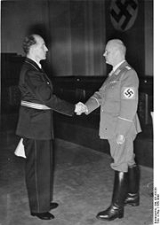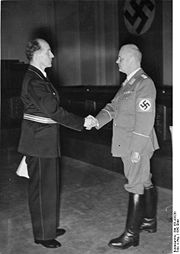
Otto Georg Thierack
Encyclopedia

Jurist
A jurist or jurisconsult is a professional who studies, develops, applies, or otherwise deals with the law. The term is widely used in American English, but in the United Kingdom and many Commonwealth countries it has only historical and specialist usage...
and politician
Politician
A politician, political leader, or political figure is an individual who is involved in influencing public policy and decision making...
.
Early life and career
Thierack was born in WurzenWurzen
Wurzen is a town in the Leipzig district, in the Free State of Saxony, Germany. It is situated on the river Mulde, here crossed by two bridges, 25 km east of Leipzig, by rail N.E. of Leipzig on the main line to Dresden...
in Saxony
Saxony
The Free State of Saxony is a landlocked state of Germany, contingent with Brandenburg, Saxony Anhalt, Thuringia, Bavaria, the Czech Republic and Poland. It is the tenth-largest German state in area, with of Germany's sixteen states....
. He took part in the First World War from 1914 to 1918 as a volunteer, reaching the rank of lieutenant
Lieutenant
A lieutenant is a junior commissioned officer in many nations' armed forces. Typically, the rank of lieutenant in naval usage, while still a junior officer rank, is senior to the army rank...
. He suffered a face injury and was decorated with the Iron Cross
Iron Cross
The Iron Cross is a cross symbol typically in black with a white or silver outline that originated after 1219 when the Kingdom of Jerusalem granted the Teutonic Order the right to combine the Teutonic Black Cross placed above a silver Cross of Jerusalem....
, second class. After the war ended, he resumed his interrupted law
Law
Law is a system of rules and guidelines which are enforced through social institutions to govern behavior, wherever possible. It shapes politics, economics and society in numerous ways and serves as a social mediator of relations between people. Contract law regulates everything from buying a bus...
studies and ended them in 1920 with his Assessor (junior lawyer) examination. In the same year, he was hired as a court Assessor in Saxony.
Joining of the Nazi party
On 1 August 1932, Thierack joined the Nazi Party. After the Nazis seized powerMachtergreifung
Machtergreifung is a German word meaning "seizure of power". It is normally used specifically to refer to the Nazi takeover of power in the democratic Weimar Republic on 30 January 1933, the day Hitler was sworn in as Chancellor of Germany, turning it into the Nazi German dictatorship.-Term:The...
in 1933, he managed within a very short time to rise high in the ranks from a prosecutor to President of the People's Court (Volksgerichtshof). The groundwork on which this rise was built was not merely that Thierack had been a Nazi Party member, but rather also that he had been leader of the National Socialist jurists' organization, the so-called Rechtswahrerbund.
Nazification efforts as Justice Minister of Saxony
On 12 May 1933, having been appointed Saxony's justice minister, it was Thierack's job to "Nazify" justice, which was a part of the Nazis' GleichschaltungGleichschaltung
Gleichschaltung , meaning "coordination", "making the same", "bringing into line", is a Nazi term for the process by which the Nazi regime successively established a system of totalitarian control and tight coordination over all aspects of society. The historian Richard J...
that he had to put into practice in Saxony. After going through several mid-level professional posts, he became Vice President of the Reich Court in 1935 and in 1936 President of the Volksgerichtshof, which had been newly founded in 1934. He held this job, interrupted as it was by two stints in the armed forces, until 1942, when he was succeeded in the position by Roland Freisler
Roland Freisler
Roland Freisler was a prominent and notorious Nazi lawyer and judge. He was State Secretary of the Reich Ministry of Justice and President of the People's Court , which was set up outside constitutional authority...
.
Persecution and debasement of law as Reich Minister of Justice
On 20 August 1942, Thierack assumed the office of Reich Minister of Justice. He introduced the monthly Richterbriefe in October 1942, in which were presented model – from the Nazi leaders' standpoint – decisions, with names left out, upon which German jurisprudence was to be based. He also introduced the so-called Vorschauen and Nachschauen ("previews" and "inspections"). After this, the higher state court presidents, in proceedings of public interest, had at least every fortnight to discuss with the public prosecutor's office and the State Court President – who had to pass this on the responsible criminal courts – how a case was to be judged before the court's decision.Thierack not only made penal prosecution of all unpopular persons and groups harsher. "Antisocial" convicts on the whole were much more often turned over to the SS
Schutzstaffel
The Schutzstaffel |Sig runes]]) was a major paramilitary organization under Adolf Hitler and the Nazi Party. Built upon the Nazi ideology, the SS under Heinrich Himmler's command was responsible for many of the crimes against humanity during World War II...
. This usually meant Jews, Poles
Poland
Poland , officially the Republic of Poland , is a country in Central Europe bordered by Germany to the west; the Czech Republic and Slovakia to the south; Ukraine, Belarus and Lithuania to the east; and the Baltic Sea and Kaliningrad Oblast, a Russian exclave, to the north...
, Russians
Russians
The Russian people are an East Slavic ethnic group native to Russia, speaking the Russian language and primarily living in Russia and neighboring countries....
, and Gypsies. Soon afterwards, though, he utterly forwent any pretense of legality and simply began handing these people over to the SS. Thierack came to an understanding with Heinrich Himmler
Heinrich Himmler
Heinrich Luitpold Himmler was Reichsführer of the SS, a military commander, and a leading member of the Nazi Party. As Chief of the German Police and the Minister of the Interior from 1943, Himmler oversaw all internal and external police and security forces, including the Gestapo...
that certain categories of prisoners were to be, to use their words, "annihilated through work". Ever since coming to office as Reich Minister of Justice in August 1942, Thierack had seen to it that the lengthy paperwork involved in clemency proceedings for those sentenced to death was greatly shortened.
At Thierack's instigation, the execution shed at Plötzensee Prison
Plötzensee Prison
Plötzensee Prison was a Prussian institution built in Berlin between 1869 and 1879 near the lake Plötzensee, but in the neighbouring borough of Charlottenburg, on Hüttigpfad off Saatwinkler Damm. During Adolf Hitler's time in power from 1933 to 1945, more than 2,500 people were executed at...
in Berlin
Berlin
Berlin is the capital city of Germany and is one of the 16 states of Germany. With a population of 3.45 million people, Berlin is Germany's largest city. It is the second most populous city proper and the seventh most populous urban area in the European Union...
was outfitted with eight iron hooks in December 1942 so that several people could be put to death at once, by hanging
Hanging
Hanging is the lethal suspension of a person by a ligature. The Oxford English Dictionary states that hanging in this sense is "specifically to put to death by suspension by the neck", though it formerly also referred to crucifixion and death by impalement in which the body would remain...
(there had already been a guillotine
Guillotine
The guillotine is a device used for carrying out :executions by decapitation. It consists of a tall upright frame from which an angled blade is suspended. This blade is raised with a rope and then allowed to drop, severing the head from the body...
there for quite a while). At the mass executions beginning on 7 September 1943, it also happened that some prisoners were hanged "by mistake". Thierack simply covered up these mistakes and demanded that the hangings continue.
Suicide after war
After the AlliesAllies of World War II
The Allies of World War II were the countries that opposed the Axis powers during the Second World War . Former Axis states contributing to the Allied victory are not considered Allied states...
arrested him, Thierack committed suicide in Sennelager
Sennelager
Sennelager is a village in Germany that forms part of the City of Paderborn. It is notable by the presence of a British army barracks, where the 20th Armoured Brigade are currently situated...
, Paderborn
Paderborn
Paderborn is a city in North Rhine-Westphalia, Germany, capital of the Paderborn district. The name of the city derives from the river Pader, which originates in more than 200 springs near Paderborn Cathedral, where St. Liborius is buried.-History:...
, by poisoning before he could be brought before the court at the Nuremberg
Nuremberg
Nuremberg[p] is a city in the German state of Bavaria, in the administrative region of Middle Franconia. Situated on the Pegnitz river and the Rhine–Main–Danube Canal, it is located about north of Munich and is Franconia's largest city. The population is 505,664...
Judges' Trial
Judges' Trial
The Judges' Trial was the third of the 12 trials for war crimes the U.S. authorities held in their occupation zone in Germany in Nuremberg after the end of World War II. These twelve trials were all held before U.S...
.

